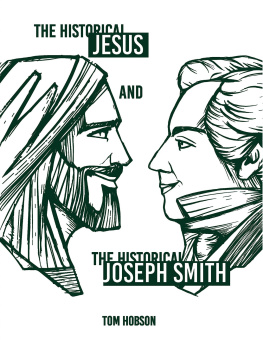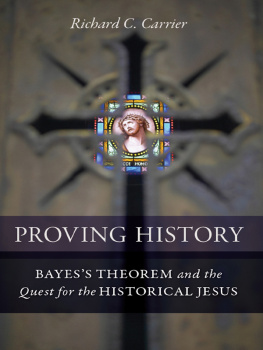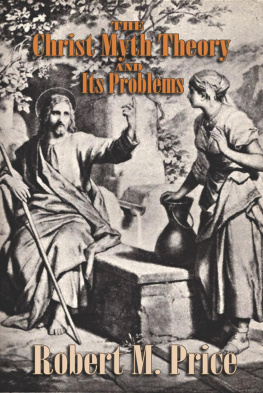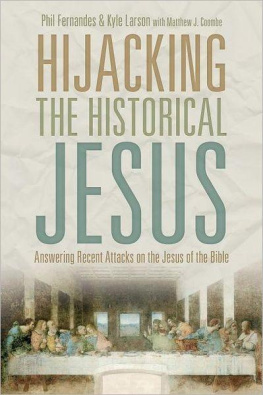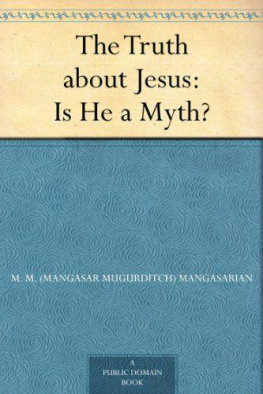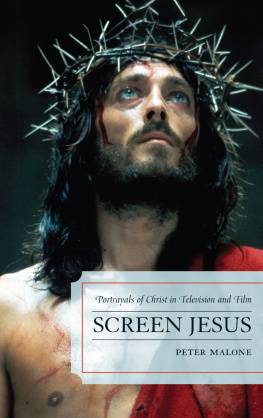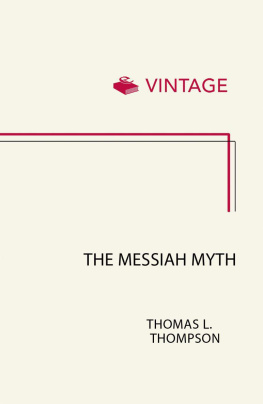Carsten Peter Thiede - Jesus, Man or Myth?
Here you can read online Carsten Peter Thiede - Jesus, Man or Myth? full text of the book (entire story) in english for free. Download pdf and epub, get meaning, cover and reviews about this ebook. year: 2014, publisher: Lion Books, genre: Religion. Description of the work, (preface) as well as reviews are available. Best literature library LitArk.com created for fans of good reading and offers a wide selection of genres:
Romance novel
Science fiction
Adventure
Detective
Science
History
Home and family
Prose
Art
Politics
Computer
Non-fiction
Religion
Business
Children
Humor
Choose a favorite category and find really read worthwhile books. Enjoy immersion in the world of imagination, feel the emotions of the characters or learn something new for yourself, make an fascinating discovery.

- Book:Jesus, Man or Myth?
- Author:
- Publisher:Lion Books
- Genre:
- Year:2014
- Rating:4 / 5
- Favourites:Add to favourites
- Your mark:
- 80
- 1
- 2
- 3
- 4
- 5
Jesus, Man or Myth?: summary, description and annotation
We offer to read an annotation, description, summary or preface (depends on what the author of the book "Jesus, Man or Myth?" wrote himself). If you haven't found the necessary information about the book — write in the comments, we will try to find it.
Jesus, Man or Myth? — read online for free the complete book (whole text) full work
Below is the text of the book, divided by pages. System saving the place of the last page read, allows you to conveniently read the book "Jesus, Man or Myth?" online for free, without having to search again every time where you left off. Put a bookmark, and you can go to the page where you finished reading at any time.
Font size:
Interval:
Bookmark:

Text copyright 2005 Carsten Peter Thiede
This edition copyright 2005 Carsten Peter Thiede
The right of Carsten Peter Thiede to be identified as the author of this work has been asserted by him in accordance with the Copyright, Designs and Patents Act 1988.
All rights reserved. No part of this publication may be reproduced or transmitted in any form or by any means, electronic or mechanical, including photocopy, recording, or any information storage and retrieval system, without permission in writing from the publisher.
Published by Lion Books
an imprint of
Lion Hudson plc
Wilkinson House, Jordan Hill Road,
Oxford OX2 8DR, England
www.lionhudson.com/lion
ISBN 978 0 7459 5147 8
e-ISBN: 978 0 7459 5772 2
First edition 2005
Acknowledgments
pp. 16, 32, 3435, 36, 4041, 45, 4647, 49, 52, 55, 69, 72, 77, 78, 103105, 111, 120, 124, 127, 128, 130, 132, 133, 134, 137, 142, 143, 145, 146, 154, 156 Scripture quotations are from the New Revised Standard Version published by HarperCollins Publishers, copyright 1989 by the Division of Christian Education of the National Council of the Churches of Christ in the USA, and are used by permission. All rights reserved. pp. 60, 6364, 65, 66, 99 Scripture quotations are from the Revised English Bible with the Apocrypha copyright 1989 by Oxford University Press and Cambridge University Press.
A catalogue record for this book is available
from the British Library
Cover image: Corbis
Publishers Note
Sadly, the author Carsten Peter Thiede
died during the production of this book.
He had completed the text of the book
but was unable to finish his checking
of final proofs. The publishers have
endeavoured to complete it
as accurately as he would have wished.
CONTENTS
INTRODUCTION
The Jesus of history and the Christ of faith one and the same or two different persons?
Alone in human history, Jesus of Nazareth did not simply die, rot in a tomb then disappear into the history books or into obscurity. His followers claim that he not only rose from the dead and ascended into heaven, but that he is very much alive today, a real presence in their daily lives and prayers. Critics of Christianity and not a few theologians have tried to come to terms with this two-fold identity by dividing the Jesus of history from the Christ of faith. This Christ of faith, proclaimed by the churches and denominations and experienced by Christians the world over, has been constructed, deconstructed and reconstructed according to the doctrinal decisions of churches and the predilections of synods, committees and individuals. The current debates about controversial, ethical issues are a clear pointer in this direction. The Christ of faith can also be the deeply felt personal Christ of committed men and women who practise what they believe and lead lives that exemplify neighbourly love and the willingness to share the good news as it is recorded in the Gospels and the other twenty-three writings of the New Testament. In some African and Asian countries the risks are high: more Christians have been tortured and killed in the past century than at any other time in history. Believing in the Christ of faith and following him is anything but an academic pursuit.
The Jesus of history, on the other hand, has become a point of conflict between academics who reduce him to snippets of controversial information and others who claim that he is actually the most reliably documented person of antiquity. Still others, somewhere in the middle, claim that we know enough to trust the records but are too far removed from events to prove that they happened as we find them in the New Testament. One simple result of this continuous debate has been mentioned many times, particularly in the media and even from the pulpit: the Jesus of history and the Christ of faith cannot be reconciled. They are two distinct identities, the one to be studied from fragmentary and disputable sources, the other to be proclaimed and believed as best we can.
It should test our sense of irony. Critics and enemies of Christianity quite like the Jesus of history, as it is here that they think they can disprove the claims of the New Testament. Was Jesus born in Bethlehem? Did he rise on the third day? These are solid, historical issues, which many doubters think are the stuff of legend rather than the basis of factual accounts. Conversely, many committed Christians do not like the Jesus of history at all, since they feel it is here that their personal faith may be challenged. Did Jesus really say everything the Gospels record, and did he say it quite like that? Better not to face those questions, or so they think. But the very nature of Jesus and the Christian message leaves no room for choice. The Jesus of history and the Christ of faith are two inseparable sides of the same coin. Anyone looking at a coin can see only one side at a time. And yet it is obvious that the other, invisible side must exist, for otherwise the coin would be without value. If we look at the Jesus of history, we know that the other side, the Christ of faith, is also there, even though we cannot see it. And if we turn the coin over, the opposite experience applies. We can check that both sides exist, although we look at them separately, gaining different insights from what we see. Anyone who insists that these two sides do not make a whole but must be separated is proclaiming a dangerous falsehood. The message of Jesus Christ is indivisible. It is a message both of history and of faith.
The prevailing attitude of doubt is not a modern phenomenon. Ideological tenets began to gain a foothold in the eighteenth and nineteenth centuries in the guise of post-Enlightenment theories. New philosophies, such as existentialism, offered a quest for meaning after the devastation of the First World War. These tenets changed continental theology beyond recognition. It was no longer intellectually correct to believe in the miracles of Jesus, irrespective of their well-attested historicity, because miracles do not happen, and, as one theologian famously put it, it was no longer possible to believe in the resurrection and ascension of Christ in an age of electric shavers. Step by step, historical analysis gave way to the ideology of preconceived ideas about the nature of the Bible and its message. It was an irresistible development that soon focused on the four Gospels. For as long as the Gospels were understood to be what they plainly claim to be, that is, historical stories about a historical person, written as the earliest records tell us by eyewitnesses (Matthew and John) or companions and interviewers of eyewitnesses (Mark and Luke), there was no reason to question even those accounts that could not be reconciled with our own everyday experience. Once there had been room for trust and awe, but now this has yielded to a so-called hermeneutics of distrust, where faith in the records is seen as naive and doubt is hailed as sincere and scholarly. Of necessity, the Gospels have had to be redated to the period between the seventies and the end of the first century. A pivotal event caused this decision. In AD 30, Jesus predicted the destruction of the Temple; the Romans destroyed it in AD 70. Since Jesus was no longer allowed to be seen as a true prophet, scholars declared that the Gospels must have been written after the event, and they interpreted Jesus prophecy as a creation of the early church, which wanted Jesus to be seen as the true Son of God rather than an ordinary human being with the gift of the gab. If this looks like a caricature, countless theological publications of the twentieth and early twenty-first centuries unfortunately show that it is not. The results of this reasoning have been taught to students of theology, future parish priests and, as a consequence, to unwitting congregations and pupils in RE classes. Even conservative and evangelical (to use the common labels) Bible and theological colleges have occasionally given in to the temptation of accepting mainstream tendencies rather than facing head on the unhistorical and anti-historical tampering with sources.
Next pageFont size:
Interval:
Bookmark:
Similar books «Jesus, Man or Myth?»
Look at similar books to Jesus, Man or Myth?. We have selected literature similar in name and meaning in the hope of providing readers with more options to find new, interesting, not yet read works.
Discussion, reviews of the book Jesus, Man or Myth? and just readers' own opinions. Leave your comments, write what you think about the work, its meaning or the main characters. Specify what exactly you liked and what you didn't like, and why you think so.

